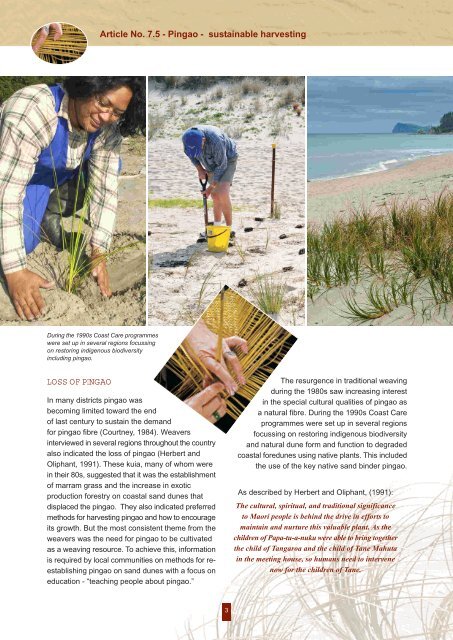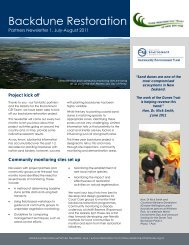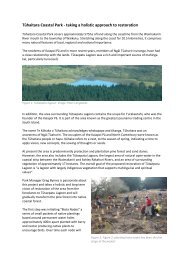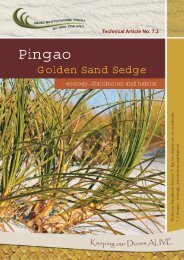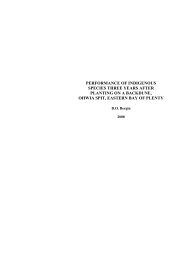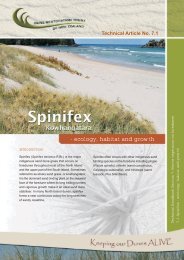Pingao sustainability for weaving - Dune Restoration Trust
Pingao sustainability for weaving - Dune Restoration Trust
Pingao sustainability for weaving - Dune Restoration Trust
Create successful ePaper yourself
Turn your PDF publications into a flip-book with our unique Google optimized e-Paper software.
LOSS OF PINGAO<br />
Article <strong>Dune</strong>s No. <strong>Trust</strong> 7.5 Handbook - <strong>Pingao</strong> - Article sustainable No. 6 harvesting<br />
- Fences on Coastal Sand <strong>Dune</strong>s<br />
During the 1990s Coast Care programmes<br />
were set up in several regions focussing<br />
on restoring indigenous biodiversity<br />
including pingao.<br />
In many districts pingao was<br />
becoming limited toward the end<br />
of last century to sustain the demand<br />
<strong>for</strong> pingao fibre (Courtney, 1984). Weavers<br />
interviewed in several regions throughout the country<br />
also indicated the loss of pingao (Herbert and<br />
Oliphant, 1991). These kuia, many of whom were<br />
in their 80s, suggested that it was the establishment<br />
of marram grass and the increase in exotic<br />
production <strong>for</strong>estry on coastal sand dunes that<br />
displaced the pingao. They also indicated preferred<br />
methods <strong>for</strong> harvesting pingao and how to encourage<br />
its growth. But the most consistent theme from the<br />
weavers was the need <strong>for</strong> pingao to be cultivated<br />
as a <strong>weaving</strong> resource. To achieve this, in<strong>for</strong>mation<br />
is required by local communities on methods <strong>for</strong> reestablishing<br />
pingao on sand dunes with a focus on<br />
education - “teaching people about pingao.”<br />
3<br />
The resurgence in traditional <strong>weaving</strong><br />
during the 1980s saw increasing interest<br />
in the special cultural qualities of pingao as<br />
a natural fibre. During the 1990s Coast Care<br />
programmes were set up in several regions<br />
focussing on restoring indigenous biodiversity<br />
and natural dune <strong>for</strong>m and function to degraded<br />
coastal <strong>for</strong>edunes using native plants. This included<br />
the use of the key native sand binder pingao.<br />
As described by Herbert and Oliphant, (1991):<br />
The cultural, spiritual, and traditional significance<br />
to Maori people is behind the drive in ef<strong>for</strong>ts to<br />
maintain and nurture this valuable plant. As the<br />
children of Papa-tu-a-nuku were able to bring together<br />
the child of Tangaroa and the child of Tane Mahuta<br />
in the meeting house, so humans need to intervene<br />
now <strong>for</strong> the children of Tane.


